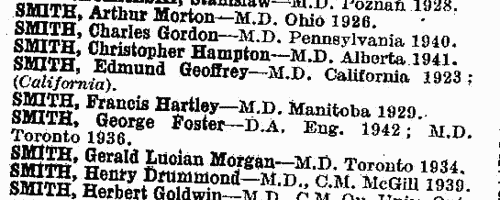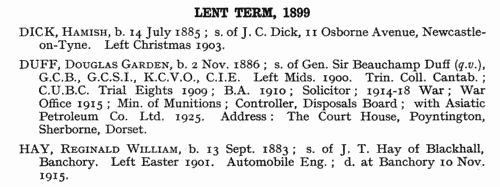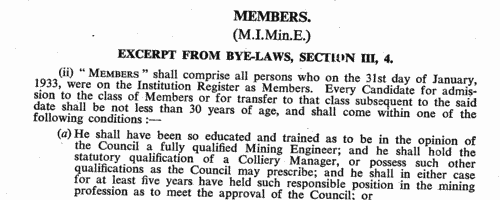Add this eBook to your basket to receive access to all 975 records. Our indexes include entries for the spelling blair. In the period you have requested, we have the following 975 records (displaying 921 to 930): These sample scans are from the original record. You will get scans of the full pages or articles where the surname you searched for has been found. Your web browser may prevent the sample windows from opening; in this case please change your browser settings to allow pop-up windows from this site. Foreign doctors in Britain
(1948)
This Medical Directory appendix lists medical practitioners temporarily registered in Great Britain under Defence Regulation 32B. The list gives no more than full name (surname first), and qualification (with place and date). | Sample scan, click to enlarge

| Secretaries of National Health Insurance Committees
(1948)
This appendix to the Medical Directory lists honorary secretaries of National Healh Insurance local medical and panel committees in each of the English, Scottish and Welsh counties and county boroughs, and for Belfast and the six counties of Northern Ireland. | Sample scan, click to enlarge

| Shipping and Forwarding Agents: London
(1948)
The Institute of Shipping and Forwarding Agents was incorporated under licence by the Board of Trade 19 December 1944. This third edition of the List of Members gives surnames, initials, and company address of practising members, and date of becoming Associate (A) or Fellow (F), arranged by the eight geographical branches - Bristol Channel; Humber District; Liverpool and District; London; Manchester and District; Scottish; Southampton and District; and Overseas. In addition, there are similar lists of Honorary Members and Non-Practising Members; and a list of 109 Student Members (those marked with an asterisk having passed the institute's examination). | Sample scan, click to enlarge

| Boys entering Trinity College, Glenalmond
(1949)
Trinity College, Glenalmond, Perthshire, was originally founded as a college at which young men might be trained for the ministry of the Scottish Episcopal Church, and the sons of the laity might be educated and brought up in the faith and tradition of the Church. In 1876 the Theological College was transferred to Edinburgh, Glenalmond remaining as a boys' school. This second edition of the school register, edited by G. St Quintin, was published in 1955, incorporating the text of the first edition prepared by E. W. Neish. The scholars are listed by term of entering the school, and then alphabetically by surname; the details then given are full christian names, date of birth; name of father; any distinctions within the school; and then a career synopsis, with date and place of death where known. Of course, for the boys from 1940 onwards, their career was ahead of them at the time of compilation, and the entries are more basic. | Sample scan, click to enlarge

| Members of the Institution of Mining Engineers (M. I. Min. E.)
(1949)
The Institution of Mining Engineers was established 1 July 1889 and incorporated by royal charter 9 February 1915. This list of members is corrected up to 28 December 1949. Five grades of members are listed: Honorary Members (Hon. M. I. Min. E.); Members (M. I. Min. E.); Associate Members (Assoc. M. I. Min. E.); Students (Stud. I. Min. E.); and Associates (Assoc. I. Min. E.). The grade of Member comprised all persons who were registered as associates on 31 January 1933: every candidate for admission to that class after that date must be a person at least 30 years of age who 'shall have been so educated and trained as to be in the opinion of the Council a fully qualified Mining Engineer' and have acted for at least five years as a qualified colliery manager, &c.; or 'he shall be a person whose position and attainments in Science or Technology justify, in the opinion of the Council, his election as a Member'. The members' names are listed alphabetically (in bold) by surname and christian name, with full address. On the right hand side are initials indicating to which federated institute he or she belonged: M. C., Midland Counties Institution of Engineers; M. G., Manchester Geological and Mining Society; M. I., Midland Institute of Mining Engineers; N. E., North of England Institute of Mining and Mechanical Engineers; N. S., North Staffordshire Institute of Mining Engineers; S. S., South Staffordshire and Warwickshire Institute of Mining Engineers; and S. W., the South Western Society of Mining Engineers. | Sample scan, click to enlarge

| British Dentists
(1950)
The Dentists Register is the official register of British dental practitioners. For each dentist the original certificate number is given; name (surname first, in bold; in the case of married women, maiden name is also usually given); address (in italics); date of registration; and the qualification entitling registration, with any additional qualifications, with year and place of qualification. Many of the older dentists, already practising by 1921, were qualified by virtue of the Dentists Act of that year. | Sample scan, click to enlarge

| British Dentists and Directors of Dentistry Businesses
(1950)
The Dentists Register is the official register of British dental practitioners. At the rear of the book is this section - List of 1. Bodies Corporate carrying on the Business of Dentistry in Conformity with Section 5 of the Dentists Act, 1921. 2. Directors of Bodies Corporate kept under Section 5(1)(b) of the Act. In each case there is the full name of the company (in bold) and the address of its registered office (in italics); addresses of branches; date of incorporation; names of directors (those marked with asterisks being registered dentists), and operating staff. The names in this section, corrected to 1 January 1950, are thus largely of the dental staff of these corporations. | Sample scan, click to enlarge

| Chemists
(1950)
The Royal Institute of Chemistry was founded in 1877, and was open only to British subjects (and also, in due course, to citizens of the newly-created Republic of Ireland). Associates of the institute (A. R. I. C.) qualified either by studying chemistry, physics, mathematics and an optional science for the institute's examination (which insisted on a high standard of practical laboratory efficiency); or by obtaining good honours degrees or equivalent qualifications, with chemistry as principal subject, and having undergone training in allied sciences. Associates of at least three years' standing could then be admitted to the Fellowship (F. R. I. C.) either by taking a further examination in a special branch of chemistry, or by submitting the results of work or evidence of experience sufficient to justify the Council in granting exemption from such further examination. This register of fellows and associates, correct to 31 August 1950, contains 11,545 names, arranged alphabetically, surname first (in capitals), with qualifications, current address, telephone number, and (in italics) a brief description of present post in the chemical industry. Finally, year of admission as associate (A.) (and, where appropriate, fellow (F.) is given on the right-hand side. With this may appear the notation (x) for a fellow of the Chemical Society, (y) for a member of the Society of Chemical Industry, or (z) for a joint subscriber to all three chartered bodies. | Sample scan, click to enlarge

| Estates of the Deceased: Notices under the Trustee Act
(1950)
Under the Trustee Act 1925 s. 27, notices were gazetted giving the names of deceased (surname first, in capitals); address, description, and date of death; names, addresses and occupations of persons to whom notices of claims against the estate were to be given, and names (in brackets) of personal representatives; and the date on or before which notices of claim were to be given. May 1950. | Sample scan, click to enlarge

| Estates of the Deceased: Notices under the Trustee Act
(1950)
Under the Trustee Act 1925 s. 27, notices were gazetted giving the names of deceased (surname first, in capitals); address, description, and date of death; names, addresses and occupations of persons to whom notices of claims against the estate were to be given, and names (in brackets) of personal representatives; and the date on or before which notices of claim were to be given. September 1950. | Sample scan, click to enlarge

|
Research your ancestry, family history, genealogy and one-name study by direct access to original records and archives indexed by surname.
|











